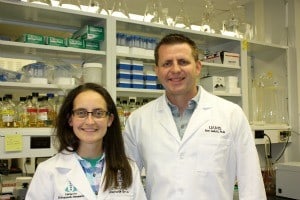UAMS Researchers Develop Technology for Identifying Proteins that Drive Disease Development
| July 19, 2012 | A new technology developed at the University of Arkansas for Medical Sciences (UAMS) for analyzing cellular processes at the smallest level could pave the way for more effective and personalized treatments of cancer and other diseases. The team lead by UAMS molecular biologist Alan Tackett, Ph.D., developed this new technology to isolate a small section of genetic material for identification of the proteins and molecular signatures that determine the fate of a cell. The study “ChAP-MS: A Comprehensive Method for Identification of Specifically Associated Proteins and Histone Posttranslational Modifications at a Single Genomic Locus” was reported in the July 19 issue of Cell Reports, available online at http://cellreports.cell.com. “The fields of Genetics and Epigenetics have been limited by the lack of tools to comprehensively identify the proteins and protein modifications that direct cellular phenotypes such as the progression of cancer” said Tackett, an associate professor in the Department of Biochemistry and Molecular Biology in the UAMS College of Medicine. “If we could identify the specific proteins turning ‘on’ or ‘off’ gene transcription during the disease development process, then we could intelligently design specific therapies and treatments to counter that process.” The approach developed by the Tackett Laboratory was funded by the Office of the Director of the National Institutes of Health. Tackett, who also serves as a director of the UAMS Proteomics Facility, said there was previously no method to comprehensively identify all of the proteins and protein modifications present at a defined, small region of chromatin – the combination of DNA and proteins that make up a chromosome. Certain chromosome proteins and modified proteins have been linked to cancer and other diseases. The researchers developed a process, called Chromatin Affinity Purification with Mass Spectrometry (ChAP-MS), that allowed them to isolate a specific section of a chromosome, then identify the specifically-associated proteins and their chemical modifications. Tackett said the approach includes a built-in control method that verifies the proteins and protein modifications that are specific to the isolated piece of chromosome and those that are not. Tackett called the new approach a breakthrough in the study of epigenetics, the study of changes in gene expression or cellular characteristics caused by mechanisms regulating access to the genetic information of life. The next step, he said, will be to move this technology platform to disease model systems and patient samples for identifying protein targets for therapeutic development. In this manner, the group will be making great strides in translational science as their studies will move from the research phase to patient treatment. Lead author in the study was Stephanie Byrum, Ph.D., a National Institutes of Health postdoctoral fellow in Tackett’s laboratory. “The ChAP-MS technology provides for a union of the disciplines of genetics, bioinformatics and proteomics; which provides us with a unique angle to study disease development,” Byrum said. Joining Byrum and Tackett as authors were Ana Raman and Sean Taverna, Ph.D., from the Johns Hopkins School of Medicine, Department of Pharmacology and Molecular Sciences. Tackett credited the UAMS Proteomics Facility for making the work possible. Investment into new state-of-the-art instrumentation provided the sensitivity needed for realization of the technology, he said. The instruments in this facility provide for ultra-sensitive identification of proteins and protein modifications. The UAMS Proteomics Facility has been supported by the UAMS College of Medicine, UAMS Department of Biochemistry and Molecular Biology, Winthrop P. Rockefeller Cancer Institute, UAMS Translational Research Institute, UAMS Arkansas IDeA Network of Biomedical Research Excellence (INBRE) and the Arkansas Biosciences Institute, which was established with state’s tobacco settlement funds to identify causes and new treatments for tobacco-related diseases such as cancer. |
